Prouvé Collection Update by Vitra
Product news: Swiss furniture brand Vitra has put its latest range of updates and reissues from the archive of French designer Jean Prouvé into production (+ slideshow).
The production pieces follow a limited collection of reproductions that the brand first presented in 2011 as a collaboration with fashion brand G-Star Raw.
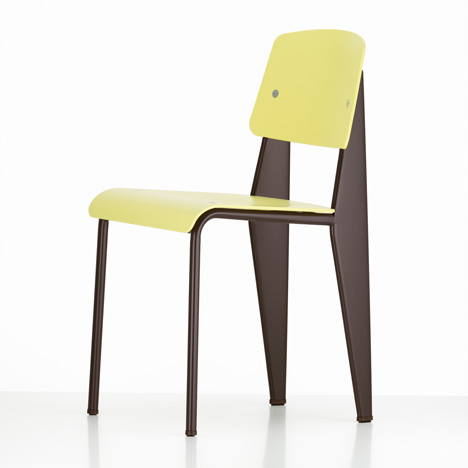
Newly available pieces include reissues of the Fauteuil Direction and Fauteuil de Salon armchairs, plus Tabouret Solvay stool. There are also updated materials and finishes to the Standard chair, EM Table and Compas Direction developed with Dutch designer Hella Jongerius and Jean Prouvé's family.
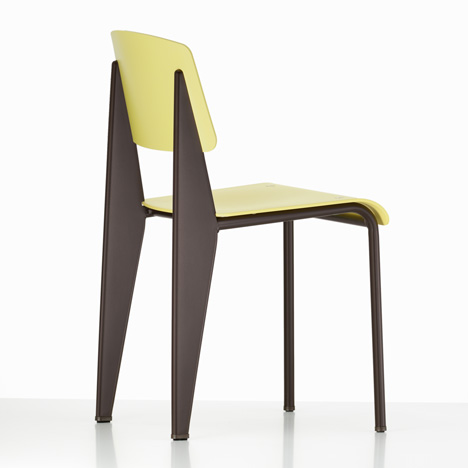
The Standard chair was originally designed in wood with thicker back legs, as these take more weight. Vitra is now producing the design with a plastic seat and back as a model named Standard SP, which has matte powder-coated metal legs.
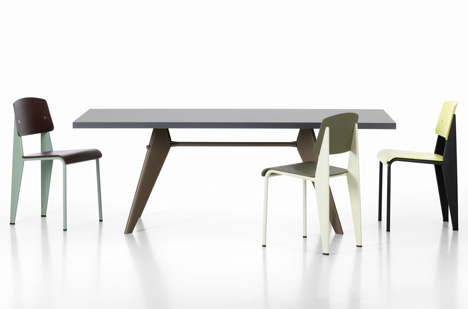
The plastic elements can be mixed and matched in various colours, and can easily be replaced.
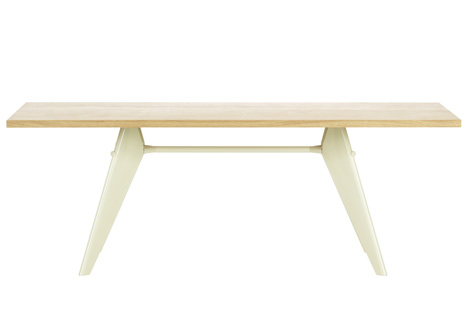
Now available with a solid wood top instead of veneered surfaces, a version of Prouvé's EM Table has been created with a powder-coated base to match the Standard SP chairs.
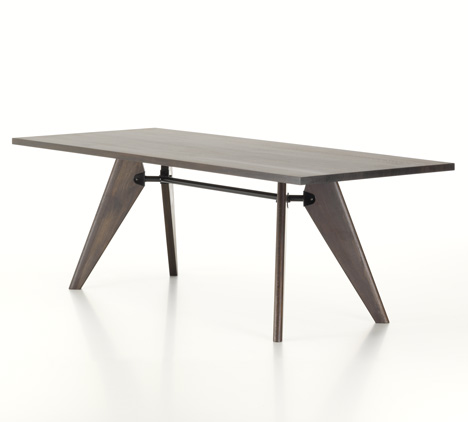
Among Prouvé's designs for chemical company Solvay, Table Solvay looks similar to the EM Table but was created with wooden legs due to the metal shortage in the Second World War. This design now can now be obtained in three different types of solid wood.
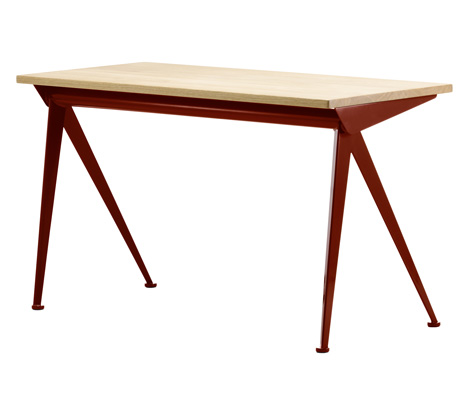
The metal legs of the Compas Direction desk are designed to look like the arms of a drawing compass and this design now also comes with a solid wood top.
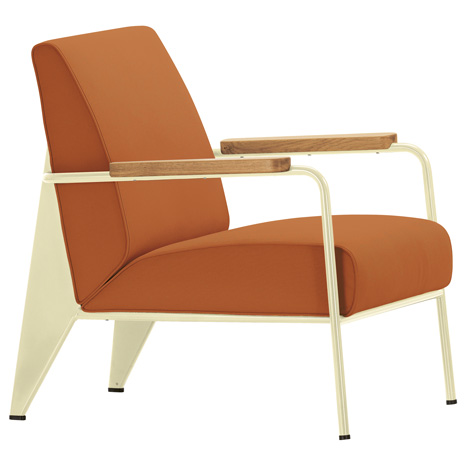
Archive designs that have been put into production include the Fauteuil Direction and Fauteuil de Salon cushioned armchairs, plus the Tabouret Solvay solid wood stool.
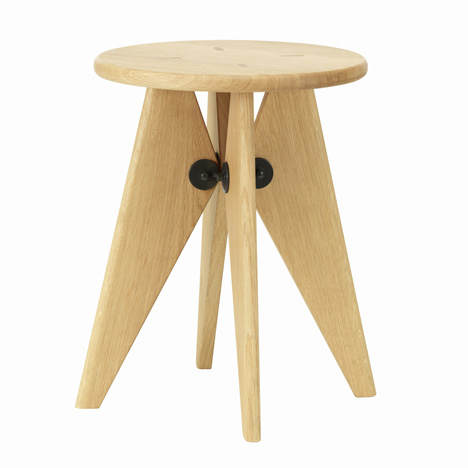
All these additions were shown as prototypes in Milan this spring and are now available to order from Vitra.
Recent furniture designs we've featured include shelves that stay propped up with the help of random found objects and brightly coloured lounge chairs that tessellate into an endless array of shapes and patterns.
We spoke to Erwan Bouroullec at the Vitra showroom in London during this year's Clerkenwell Design week - watch the interview here.
See more furniture design »
See more products by Vitra »
Here's some extra information from Vitra:
Prouvé Collection Update, developed by Vitra in Switzerland
In the fields of design, architecture and the art of engineering, the Frenchman Jean Prouvé ranks among the most versatile and innovative minds of the 20th century. From letter openers to door and window hinges, lights, furniture, façade elements, prefabricated houses, modular construction systems to large trade fair and exhibition constructions, his work includes almost everything that can be designed and requires an industrial manufacturing method. In his work as a designer, Prouvé was never searching for his own signature, but was instead striving to create logical and useful answers to required functions.
Vitra has been producing Jean Prouvé's furniture since 2001. In cooperation with the Prouvé family and the Dutch designer Hella Jongerius, the colour palette of the entire product family has been given a makeover. Reserved but contemporary shades give the Prouvé classics a fresh new image. “My father never used primary colours, but preferred a sophisticated palette of shades. Of course – he was the son of a painter!” - Catherine Prouvé.
Prouvé tables are now available with solid wood table tops and the Table Solvay is the realisation of one of Prouvé's table designs with a wooden base.
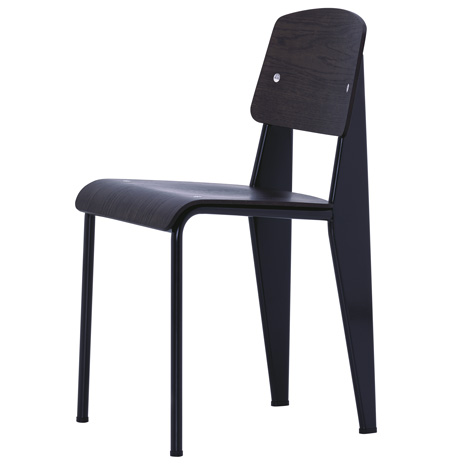
Standard SP, 1934/1950
A chair is subjected to the most strain on its back legs as it must carry the weight of the upper body. Jean Prouvé's concise interpretation of this simple recognition can be seen in the Standard chair: whereas tubular steel is sufficient for the front legs that are subjected to less strain, the chair's back legs form a voluminous hollow body that transfers the strain to the floor.
Standard SP (Siège en Plastique) brings the iconic chair up-to-date without changing anything about its form: A seat and backrest of robust plastic in a carefully chosen colour palette gives Standard SP a contemporary look. The plastic parts can be combined in various colours and easily switched out or replaced. To match the plastic surface, the bases feature a resistant, matt powder coating and, last but not least, Standard SP is an economic alternative.
To match the Standard SP, a new version of Jean Prouvé's EM Table is being launched with an HPL table top and a base that is in the same structure and colour of powder coating as the chair.
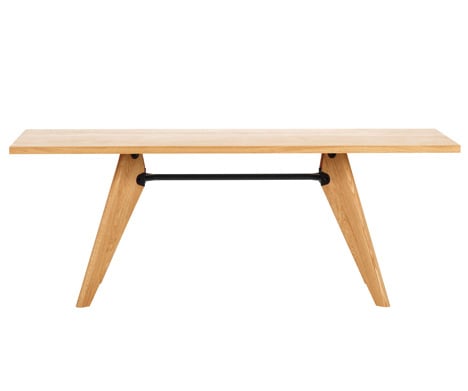
Table Solvay, 1941
During the years of 1941 and 1942, Jean Prouvé’s studios planned and realised various interior design projects for the chemical company Solvay. Among his many designs of this time, there was also a wooden table that is a prime example of Prouvé's creations: The necessities of statics and the force path are clearly reflected in his design details – similar to the later EM Table that differs from the Table Solvay due to its metal table legs. When the Table Solvay was created during World War II, there was a metal shortage and so the table legs were made of wood.
Table Solvay’s table top is available in three different kinds of wood and the base is made of the same wood. The solid oiled woods give Table Solvay a high-quality homely feel and compensate for its cool design.
The round table Guéridon has also been given a makeover: the legs, materials and surfaces are the same are those of Table Solvay, but it has an extended diameter and height.
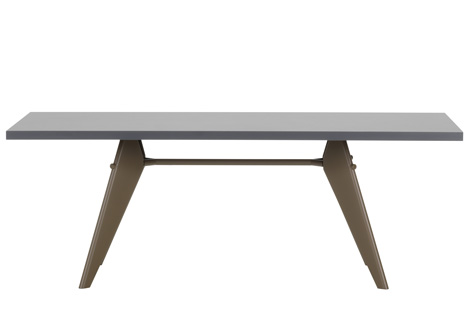
EM Table, 1950
At the beginning of the 1950s, Jean Prouvé developed the EM Table for the "Maison-Tropique" project. The table , defined by his design right down to the very last detail, follows Prouvé's typical aesthetics of necessity. It illustrates the force path and the static connections in a way that is otherwise only featured in engineering construction.
EM Table is now of even higher quality thanks to its new table tops in oiled solid wood. The solid wood table tops in oak or walnut give the table an exclusive note and offer a very pleasant feel. The height of the base is adjusted to contemporary requirements and the colour concept has been revised.
The EM Table can be ideally combined with Prouvé’s Standard chairs, but also with various other chairs.
Another new design is the EM Table with HPL table top and a base that is powdercoated in the same colours and structure as the base of the Standard SP chair.

Compas Direction, 1953
Jean Prouvé developed the Compas Table in various models around 1950, applying the construction principles that he is known for. All share elegantly splayed, narrow legs in metal, a formal reminder of a compass – in French, "le compas".
The oiled solid wood table tops give Compas Direction an individual touch. With its compact dimensions, the table is ideal for the contemporary, largely paperless, home office, where it cuts a fine figure, particularly in combination with the Fauteuil
Direction.
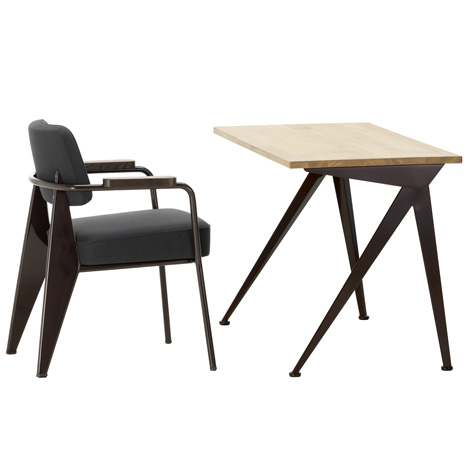
Fauteuil Direction, 1951
Fauteuil Direction is a well designed chair in which you can sit comfortably at the table. It pays homage to Prouvé's typical philosophy of focusing on design factors.
The little chair is perfect for the home office where, particularly in combination with the small desk Compas Direction, it creates an individual touch and can also be used as a comfortable dining chair. In addition, Fauteuil Direction also looks great in elegant lobbies, restaurants or waiting areas.
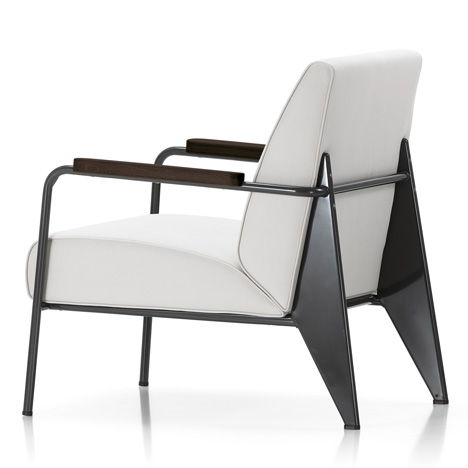
Fauteuil de Salon, 1939
Fauteuil de Salon combines plain surfaces into a complete architectural form with a comfortable seat and backrest. Rediscovered in the archives of the French design engineer, the chair’s colour was adapted for modern tastes. Thanks to the armrests in oiled solid wood and Prouvé's typical philosophy of focusing on design factors, Fauteuil de Salon goes perfectly with other products in the reworked Prouvé Collection.
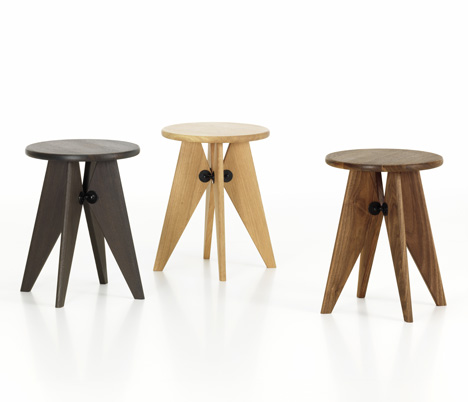
Tabouret Solvay, 1941
Tabouret Solvay is a simple, robust stool made of solid wood with a signature design that is visible at first glance: Jean Prouvé developed it, applying the design principles that he is known for. Thanks to its level seat, Tabouret Solvay can also be used as an occasional table.